
Orenburg Cossack Cavalry
The Orenburg Cossacks themselves were largely cavalry.
11th Orenburg Cossack Regiment
 |
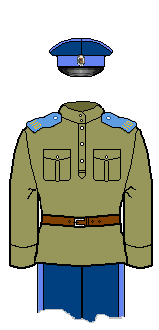 |
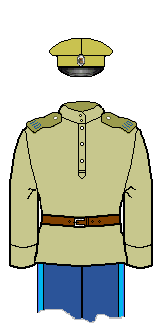 |
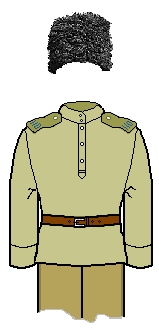 |
| Officer parade dress | Trooper | Trooper field dress | Trooper field dress |
The Host colour for the Orenburg was light blue. While this was officially also the colour of the Terek Host, it seems the Orenburg version consistently seems to have been more a mid-blue rather than the pale Terek version (but not dark blue like the Don Host).
The officer figure is shown with ermakovka style gimnastërka with gazyr cartridge holders on the breast. These returned to popularity during the civil war, when regulations were less enforced, but were never particularly common. The can also be seen on some of the other ranks.
We know that the Orenburg suffered particularly badly from supply issues. The rank and file were probably extremely poorly dressed for most of the war. Although kolchakiya.ru shows an Orenburg Cossack officer wearing a gimnastërka with cuff, sleeve and shirt piping, such finery would have been rare.
Like all steppe Cossacks the Orenburg cavalry used lances. In 1914 only half the men fought with a lance, but shortages of weapons and ammunition may have increased this fraction in the Civil War.
Uniform Details
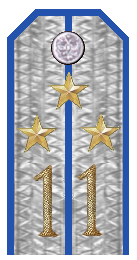 |
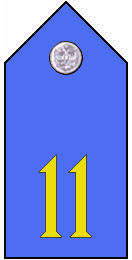 |
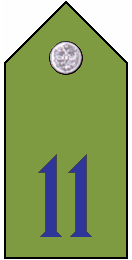 |
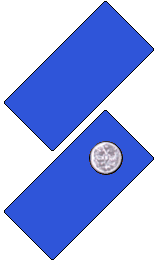 |
| Shoulderboards: Lieutenant | Shoulderboards: Trooper dress version | Shoulderboards: Trooper field version | Greatcoat collar tabs |
Dress shoulderboards were light blue. Buttons and officer lace were silver. Officer's monogram and rank markings were in gold, and for troopers in yellow.
Field shoulderboards had the number stenciled or inked in dark blue.
It appears that all the Orenburg cavalry regiments had their number only as their cipher in WWI. Independent sotnias had a straight "O".
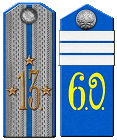 To the left are the shoulderboards of Orenburg Cossack units as shown at kolchakiya.ru.
To the left are the shoulderboards of Orenburg Cossack units as shown at kolchakiya.ru.
The officer, on the left, is a lieutenant in the 13th Orenburg Cossack Regiment.
The trooper is a sergeant in the 6th Orenburg Cossack Regiment. It has an "O" added, which rather contradicts the officer's version and is contrary to Imperial practice. (The curly shape of the O is to prevent it looking like a zero, but the official Imperial "O" had been a standard stenciled oval.)
 The furazhka peaked cap had blue crown and light blue band and piping. The papakha, shown left, had a light blue cloth with a white/silver cross for
officers. The field version was plain khaki, although officers might have a cross in white. Large shaggy papakha would seem to be the most common for this host.
The furazhka peaked cap had blue crown and light blue band and piping. The papakha, shown left, had a light blue cloth with a white/silver cross for
officers. The field version was plain khaki, although officers might have a cross in white. Large shaggy papakha would seem to be the most common for this host.
History in the RCW
The 11th Orenburg Cossack Regiment started in June 1918 as part of the 3rd Orenburg Cossack Division, moving to the 3rd Urals Corps in September. In November 1918 it was in the Ekaterinburg area, commanded by Colonel A.T. Sukin alongside the Czechs. It was soon fighting near Sarapaul.
It seems the division, formally the 11th, 12th, 17th and 18th Orenburg Cossack Regiments, plus 3rd Cossack Artillery Divizion, was deployed as separate units, even separate sotnias. The division was officially disbanded in April 1919.
The 11th Regiment was now placed in the Siberian Independent Army, as an independent HQ asset, but at least some of the time attached to General Pepelyaev's 1st Siberian Corps. They were technically part of the 5th Orenburg Cossack Brigade, alongside the 17th Regiment.
The bulk of the Siberian Army disintegrated in December 1919 after several months of defeat and disease, but the 11th Regiment survived relatively well, even though it had covered the rear on the retreats to the Tobol and Ishim. It still numbered about 700 sabres at the end of the year. The sister regiment in the Brigade, the 17th, seems to have mostly surrendered during the early winter after suffering greatly at the hands of Shchetinkin's famous partisans
The regiment made the last stage of the famous "Ice March" alongside the 3rd Barnaul Rifle Regiment separately from the main White route. The 11th Regiment arrived with a two dozen officers and about 300 Cossacks. The 3rd Barnaul had 100 officers and perhaps 400 rankers, with 10 machine-guns.
The 11th was in a better state than most units and was not merged. Instead it was place in a Composite Cossack Brigade with a Siberian Cossack Regiment. It was grouped with the 4th (Omsk) Rifle Division, composed of the 3rd Barnaul, 13th Omsk and 16th Ishim Rifle Regiments. Now commanded by Colonel A. B. Zuev, the 11th Regiment fought in the Nerchinsk area.
In August 1920 the 11th Regiment was merged into the Combined Orenburg Cossack Brigade. As Zuev commanded the 2nd Orenburg Regiment of the brigade, that was presumably where the former 11th Regiment went.
Flags

Zvegintov only records that the Orenburg Cossack Regiment and all higher numbered units were given ceremonial banners around 1856, while the lower numbers were given theirs about 1842. So all would have been a difficult state by the time of the civil war.
The basic type for that period is shown to the right (as taken from vexillographia.ru). Note that the reverse presumably would have a cross on orange in centre, on the Cossack model.
However vexillographia.ru also shows a banner of the 14th Orenburg Cossack Regiment, currently in the Hermitage museum, so during WWI some regiments must have been given Nikolais, perhaps during WWI:
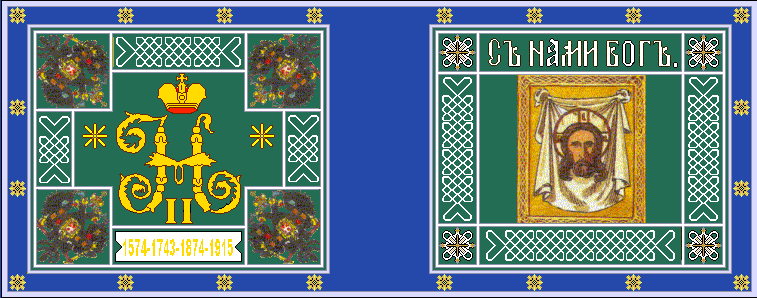
The official HQ WWI field flag for all Cossack regiments was a red diamond inside blue with the unit's number and distinguishing letters.
The official WWI commander's flag was a light blue square, with a white cross to indicate this was the second Host of this colour, with the unit's number in yellow. So for the 11th Regiment it should have been like this:
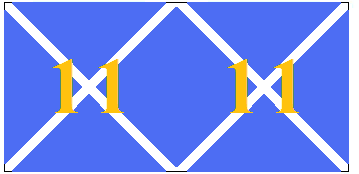
However there is a flag in a Russian museum, said to be for the civil war period, for this regiment. Either this is a variant of the commander's flag or perhaps the unit had lost its Imperial banner and this was a replacement regimental banner. I have not seen the reverse of this banner, so it could have been entirely different to the front, or perhaps like the front but without the writing.
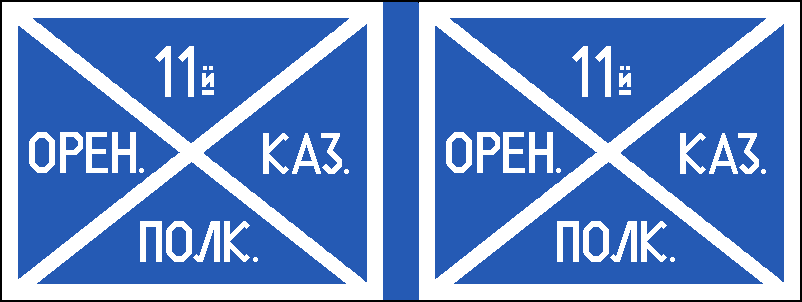
Imperial sotnia flags had an upper half of light blue with a white stripe to half way along, to indicate it was the second host of that colour, with standard sotnia colours underneath:

Vexillographia records that in 1916 the Orenburg Division was given a flag in dark green with light blue edging, which is the standard format for division flags.
Other Similar Units
It is hard to see the uniform of other Orenburg Cossack Cavalry units varying in major respects from that of the 11th Regiment, regardless of where they fought.
The Orenburg units that fought mostly with the Host are listed in orders of battle for the SouthWestern Army and Separate Orenburg Army in early 1919.
KOMUCH and Czechs
A regiment is noted being with the KOMUCH Simbirsk Forces Group on 3 October 1918 and another in their attack on Ekaterinburg to rescue the Tsar.
Siberian Army
The bulk of units raised in the north and east of the host lands fought with the Siberian Armies during the Civil War, rather than with the Orenburg Army. This placed them closer to their villages, and gave the Siberian armies a much needed cavalry element. They were mostly spread out as individual regiments in practice.
The 4th Orenburg Cossack Regiment fought with the 1st Samara Infantry Division in 1919.
At the start of 1919, the 3rd Orenburg Cossack Brigade was placed in the Western Army. In April it had 50 officers, 1,556 sabres, 22 MGs and 4 guns and was grouped with the 3rd Urals Corps (11th and 12th Urals Infantry Divisions). In July it was attached to Kolchak's 4th Infantry Division (named after General Kornilov) where it stayed through the Ice March into 1920.
Far East
Parts of the 2nd, 3rd, 5th, 6th, 12th, 17th, 18th, 34th and 4th Reserve Orenburg Cossack Regiments, plus a few sotnias, some plastoons and batteries made it through the Ice March to TransBaikal. As most were totally depleted they were merged to form the Composite Orenburg Cossack Brigade, in March 1920. As we saw above, the 11th Regiment was added later in the year. The Brigade had a 1st and 2nd Mounted Regiments, a Foot Divizion and at least one battery.
In November, under immense pressure from the Soviets they crossed into Manchuria and were transported to Primor'e. There were about 1,300 men in the unit at this time.
They fought as part of the Far Eastern Army through 1921 and 1922 in the same basic organisation, although numbers continued to drop: by September 1922 they were down to 450 sabres, 220 bayonets and only 1 gun. In mid-1921 there is a reference to the Orenburg Cossacks being still relatively well dressed. In late 1922 they crossed to Manchuria with the final collapse of White rule in the Far East.
Other Host Armies
Ataman Annenkov had a unit of Orenburg Cossacks in his little army.
The 13th Orenburg Cossack Regiment spent the bulk of the Civil War fighting with the Urals Host.
Photographs
We have collected some photographs of Orenburg Cossacks from WWI and the RCW.
Sources
Colonel A. B. Zuev wrote memoirs, mostly concentrating on the later part of the war, and especially his time with the 11th Orenburg Cossack Regiment. east-front.narod.ru